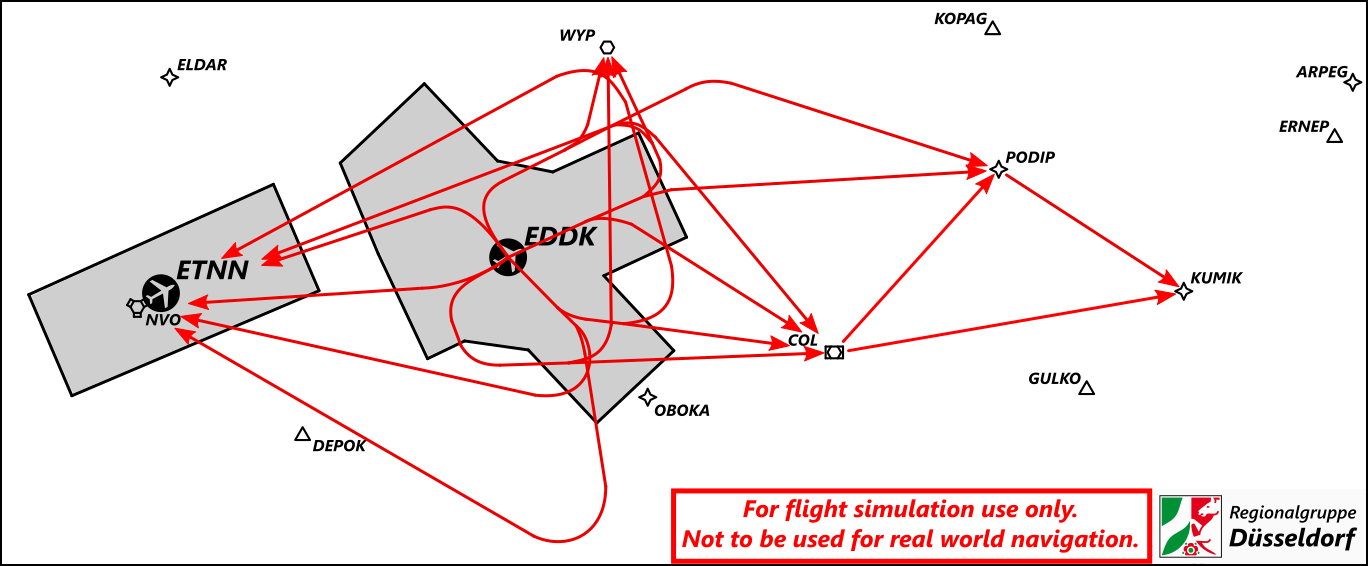Delivery
VFR traffic, in contrast to real procedures, does not have to request startup at Delivery, but can report ready for taxi directly to the ground control.
Startup: When startup clearance cannot be given immediately or the pilot is not ready for startup within the next 5 minutes during high traffic situations, the pilot needs to stay on Delivery frequency until he receives startup clearance. If an expected startup time (TSAT) exists, the pilot should be informed about it. This procedure might be necessary during events with a lot of outbound traffic.
Capacity: Due to a limited capacity for outbound traffic on ground, there should not be more than 12 active startup clearances at the same time (including SUG, PBG, TGX).
Euroscope: Delivery shall ensure that the initial climb is set and the correct SID is coded into the flightplan (very important for Center!). When issuing startup the corresponding ground state "SUG" (Startup Given) and the clearance received flag need to be set.
Departure Routes
The standard intrument departure procedures from Cologne-Bonn lead to the waypoints NVO, WYP, COL, PODIP and KUMIK. The initial climb for all departures is 5000 ft MSL.
 Departure Routes out of Cologne-Bonn
Departure Routes out of Cologne-Bonn
General Restrictions:
- The standard departure routes via COL are only used for local training flights or for flights to Frankfurt/Main EDDF.
Runway 06, 24 and 32L:
- no special procedures
Runway 14L:
- RNAV Departure Routes with Designator Q are prefered.
- Designator X is only used for aircraft with WTC heavy amd 3 engines
- Departures via NVO#P should be used for aircraft that are unable to fullfill the climb restrictions on NVO#Q or NVO#F (need to be reported by the pilot).
- NVO#W may only be assigned after coordination with the responsible arrival controller, as it crosses through approaching traffic. Appropriate flights must be announced to the approach controller by the tower before take-off.
- Designator F should be used for non-RNAV capable aircraft (unable designator F)!
Runway 14R:
- Departure Routes with Designator E are prefered.
- Departures via NVO#C should be used for aircraft that are unable to fullfill the climb restrictions on NVO #F (need to be reported by the pilot).
- NVO#V may only be assigned after coordination with the responsible arrival controller, as it crosses through approaching traffic. Appropriate flights must be announced to the approach controller by the tower before take-off.
Runway 32R:
- Departure Routes with Designator B are prefered.
- Aircraft with less then 98 t MTOW (e.g. B739, A321) should use SIDs with Designator C (noise abatement procedure).
- NVO#R should be used for RNAV capable aircraft only!
Vectored Departures
If pilots are unable to fly a standard instrument departure (even an older version of the current SID) a vectored departure can be coordinated between Delivery and Arrival.
Primary runway heading and an initial climb of 4000ft should be used. Other coordinations are always possible. At Euroscope the SID with RVxxxxx should be selected (xxxxx = first waypoint).
Datalink Clearance (PDC/DCL)
At Cologne-Bonn Airport we offer Datalink Clearance to the pilots throughout the Hoppie System and the Topsky Plugin. The airport code EDDK should be used (already preselected).
An example of the DCL message the pilot will receive can be seen below. It's important that the current ATIS Designator is entered in the remarks field. By default startup always needs to be approved seperately.
CLD 1051 220621 EDDK PDC 012 EWG6TG CLRD TO LEPA OFF 32R VIA KUMIK1C CLIMB 5000 SQUAWK 1000 ADT MDI NEXT FREQ 121.850 ATIS R REQUEST STARTUP ON 121.850
